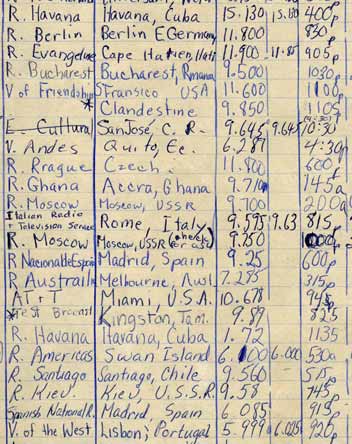BEFORE COMPUTERS
On this page...
Shortwave
Film
Audio production
BEFORE COMPUTERS
On this page...
Shortwave
Film
Audio production
BEFORE COMPUTERS
On this page...
Shortwave
Film
Audio production
SHORTWAVE
For me language learning and technology were intertwined the first day I started a foreign language – Spanish. I spent hours listening to broadcasts, including subversive stations from Cuba: local Havana broadcasters such as Radio Reloj and Radio Rebelde, both of which are still on the air. But just as fascinating were local stations from Mexico with shortwave repeaters. To this day I can remember the jingle for the furniture store "Vásquez... Hermanos Vásquez... ¡junto a Indios Verdes!"

Radio Log — 1965
Listening to shortwave broadcasts, I filled my log with notes on stations from around the world and tried my ear with a half dozen or so foreign languages: Portuguese (Voz do Oeste), French (Radio France Interntionale), Italian (IRTS), Russian (Radio Moscow), and Ukrainian (Radio Kiev).
Immediately before college, my main foreign language interest switched from Spanish to Russian, where shortwave broadcasts from the target country were of little use: the signals, beamed to Soviet sailors, were weak, and the required background knowledge was just too vast. Moreover, the Communist countries of Eastern Europe beamed most of their programming to the Americas in English and Spanish.
My interest in FL instructional video (well, "film" back in 1964) partially grew out of my experience A / V as an integral part of language instruction. Our class served as a proving ground for Encyclopedia Britannica's foray into 16-mm film-based instruction in French (Je Parle Français) and Spanish (La Familia Fernández).
I took my first stab at instructional video as an undergraduate student at Georgetown University. The GU Russian Department allotted me $17 in production funds ($150 in today's dollars!) to shoot one of the dialogs from our textbook Modern Russian. The result looks more like an American version of a Russian kapustnik. But I never got away from the notion that one could eventually find a way to do A / V for foreign-language instruction on the cheap. (The home VCR was still six years away from market, and PC-aided video would have to wait another 30 years.)
Doctor and Patient: Student acted dialog (1971)
As a graduate teaching assistant at the University of Michigan, I tried out a number of FL-video projects. Non-professional video production was in its infancy in 1973, and most of what I tried (shooting lip-synched dialogs with students to pre-recorded native-speaker sound) was more proof-of-concept than anything else.
Russian House (U of Michigan students) lip-synch textbook dialog (1976).
Still, in 1977, the University of Michigan Slavic Department awarded me production money to make a dual-language publicity movie (on color film, not black and white video) for the department-sponsored Russian House, a co-op residence for students of Russian. The film's only claim to fame today is that the voice of the English narration belongs to John Byerle, the U.S. Ambassador to Russia. The Russian voice is that of Lev Losev, a well known writer.
University of Russian House Publicity Film - English (1977).
As a graduate At the University of Michigan's Russian House, I installed a Russian cable broadcasting service. We created a twice-weekly half-hour radio program Radio Russkiy Dom, which featured a mix of native speaker - teacher - student programming, including two year-long running soap operas. Some of the recordings of Dni nashei zhizhni (1974-1975) survived and can be heard here.
BEFORE COMPUTERS
Rest of the site....
CV Philosophy
Before Computers
Tech for Textbooks
Targeted Captioning
Student Video
Workshops
Enriched E-mail
Audio Webcasts
Interactive Online
Turning Point
Skype
BEFORE COMPUTERS
Rest of the site....
CV Philosophy
Before Computers
Tech for Textbooks
Targeted Captioning
Student Video
Workshops
Enriched E-mail
Audio Webcasts
Interactive Online
Turning Point
Skype
BEFORE COMPUTERS
Rest of the site....
CV Philosophy
Before Computers
Tech for Textbooks
Targeted Captioning
Student Video
Workshops
Enriched E-mail
Audio Webcasts
Interactive Online
Turning Point
Skype